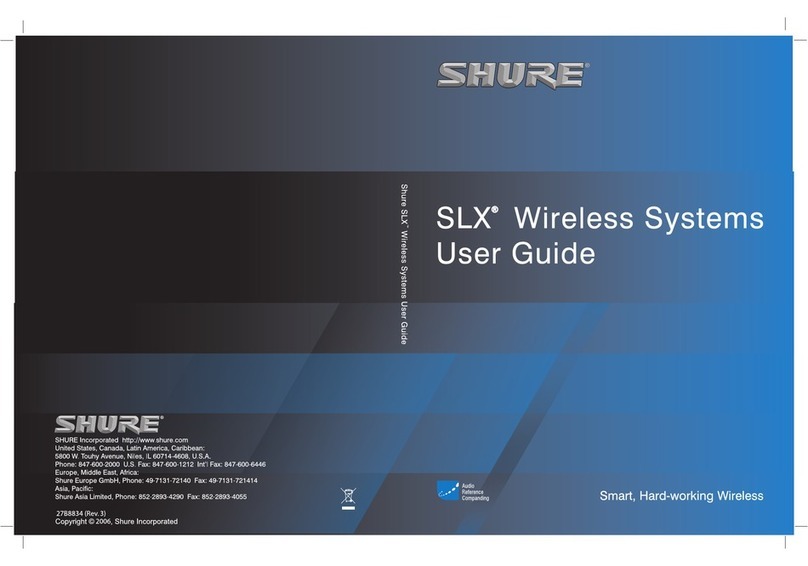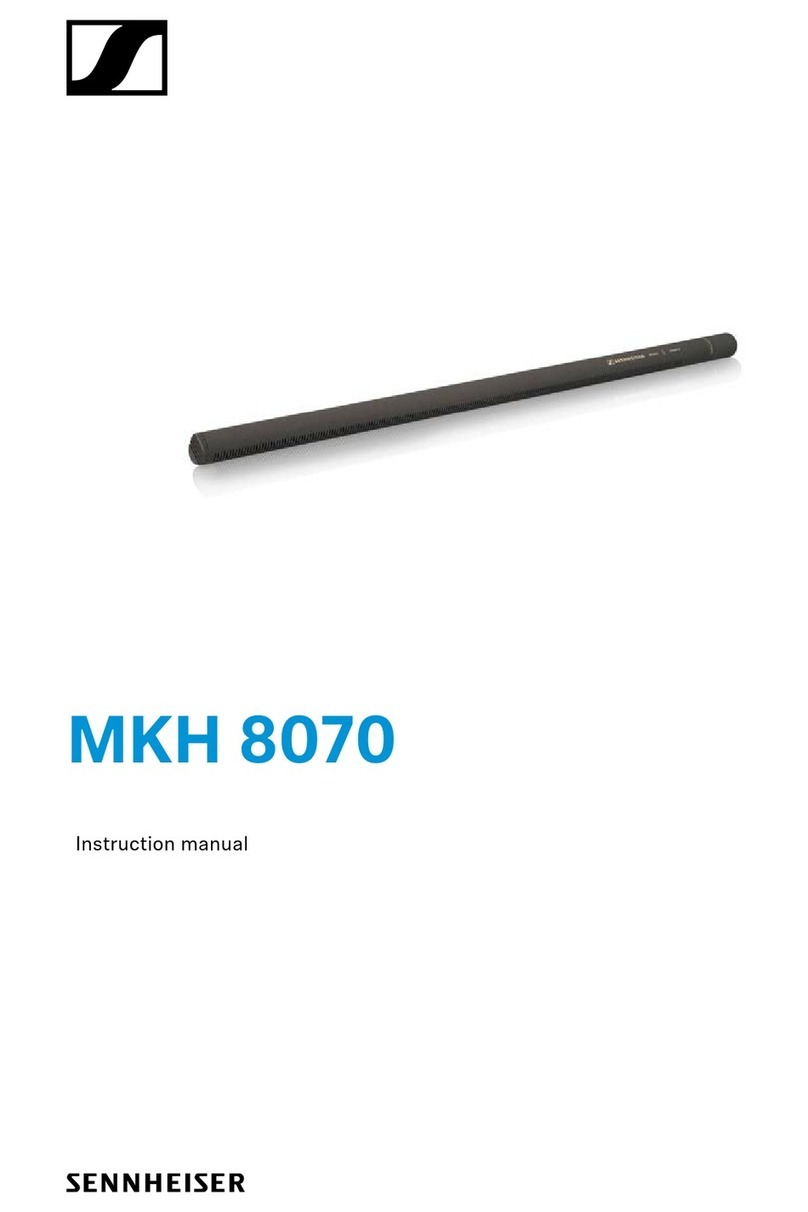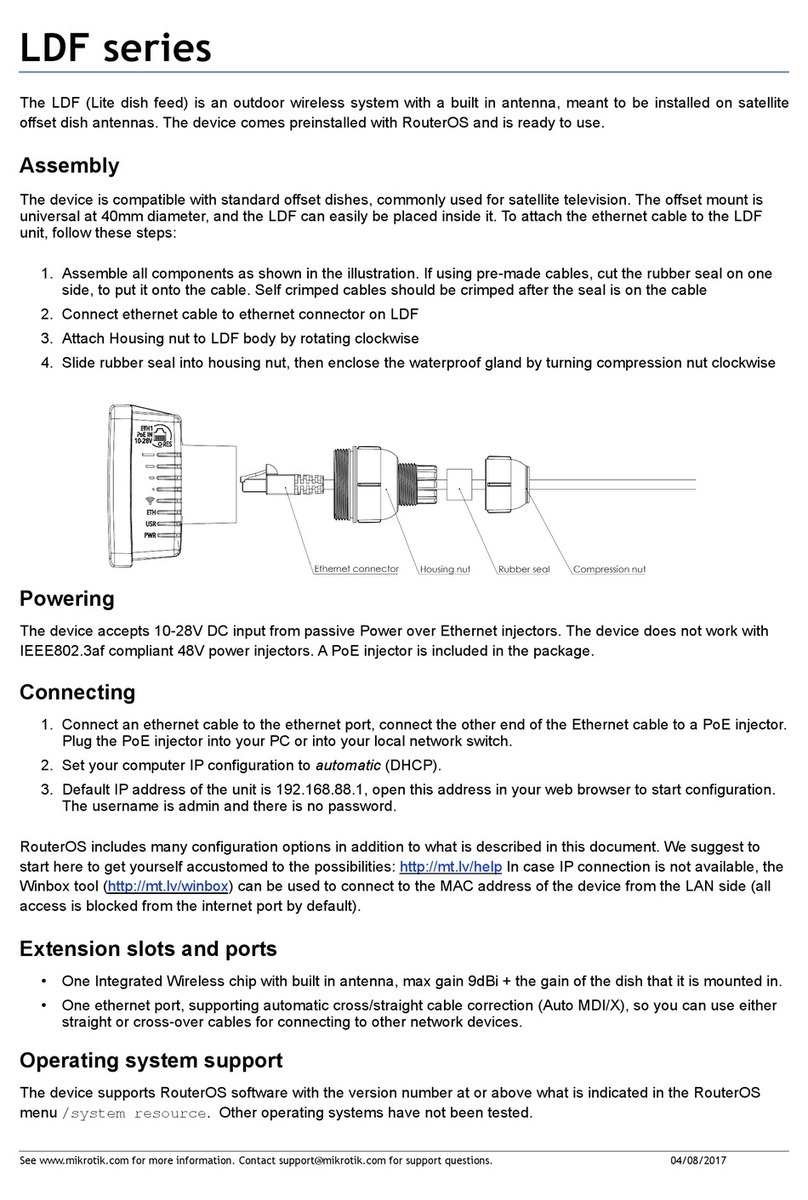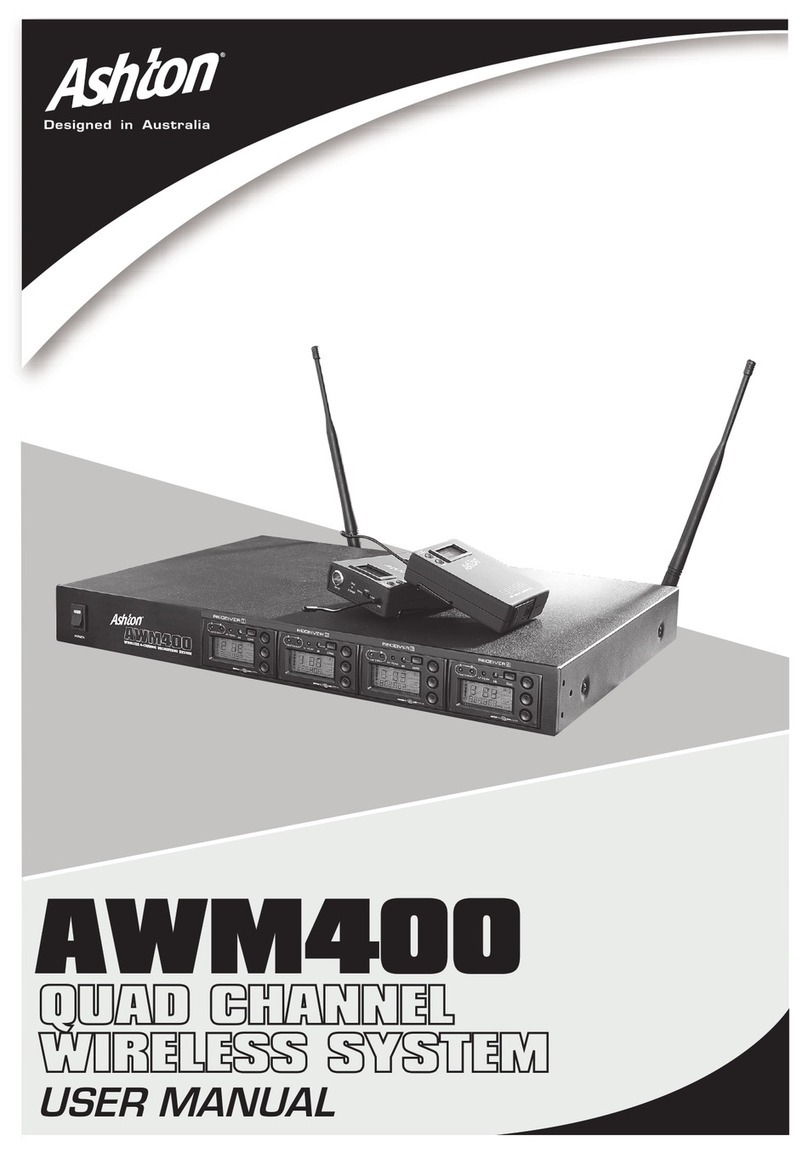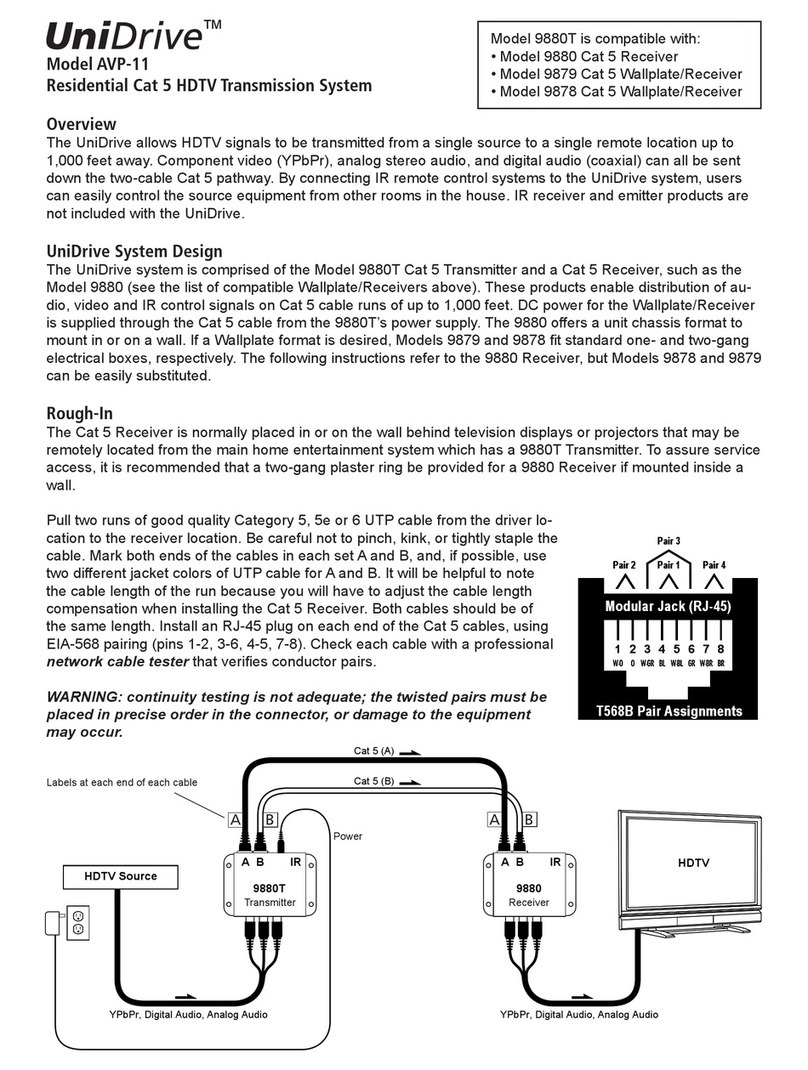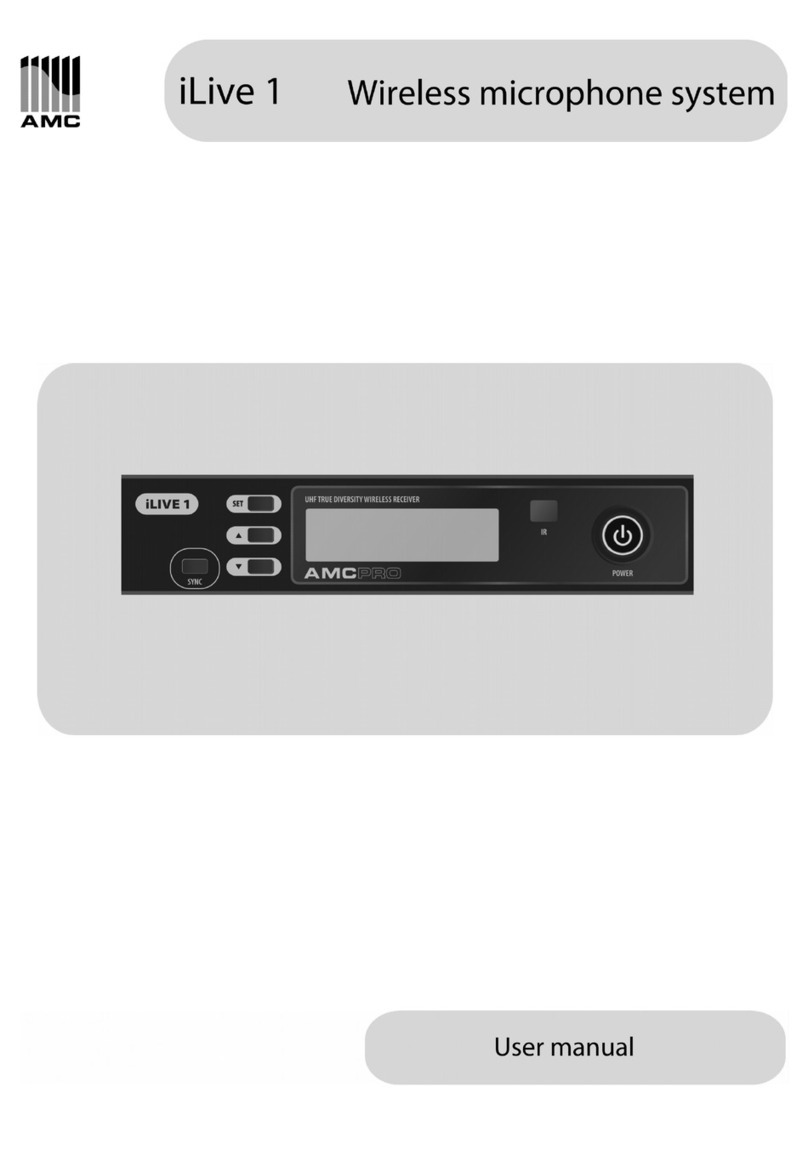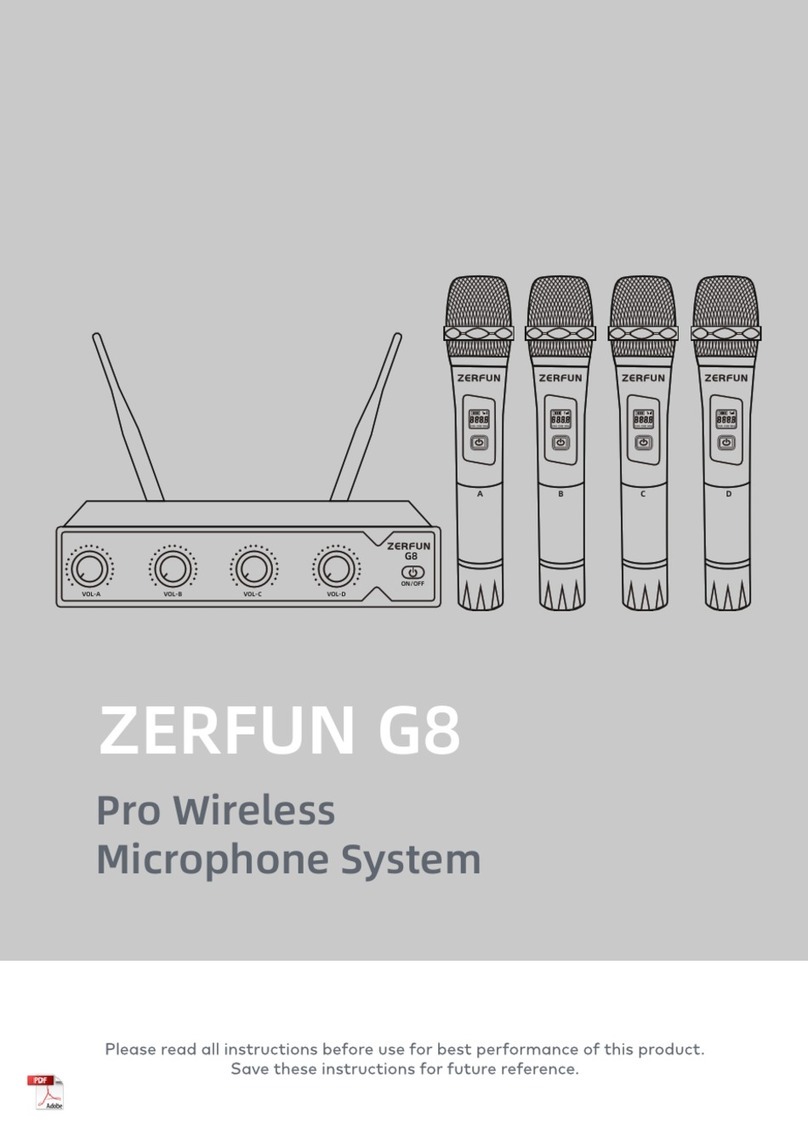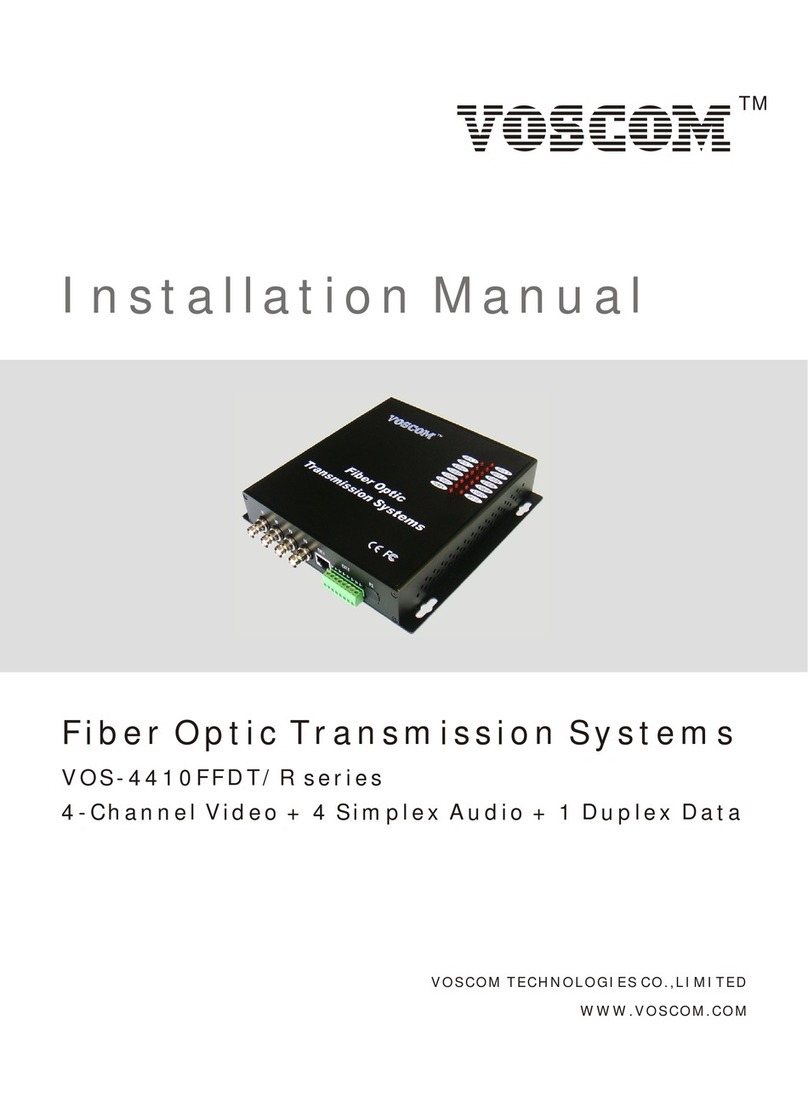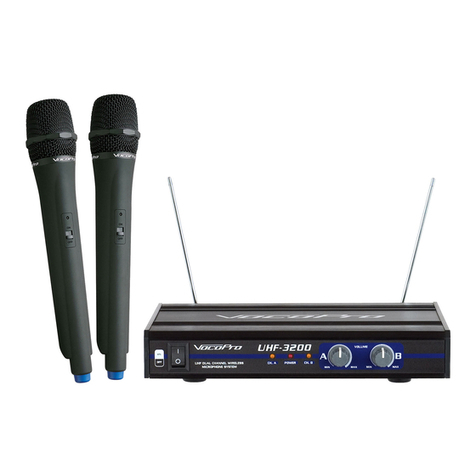BARO BR-W2 User manual

BARO SNT PRODUCT
MANUAL
www.barosnt.com
VER.1.1
2015/06/12
WIRELESS MICROPHONE & RECEIVER
1 CHANNEL SYSTEM: BR-W2

CONTENTS
www.barosnt.com
Before Use:
Device Outline………………………………………………………………...4
Device Specifications………………………………………………………...4
Device Features……………………………………………………………… 4
Package Contents…………………………………………………………… 5
Parts Listing…………………………………………………………………... 5
Cautions and Warnings………………………………………………………6
Component Descriptions:
Receiver Description and Functions………………………………………. 7
Hand Mic Description and Functions………………………………………8
Hand Mic Charger Description and Functions………………………....... 8
Installation:
Receiver Installation…………………………………………………………. 10
System Installation……………………………………………………………10
Hand Mic Installation…………………………………………………………11
Settings:
Setting the Volume……………………………………………………………12
Setting the Tone……………………………………………………………… 12
Setting the Squelch………………………………………………………….. 12
Setting the Receiver Channel…………………………………………….....13
Setting the Hand Mic Channel………………………………………………13
Operation…………………………………………………………………………………………...15
2

www.barosnt.com
Battery Replacement:
Hand Mic Battery Replacement……………………………………………. 16
Issue Diagnosis…………………………………………………………………………………… 17
Other:
Channel Frequency Chart…………………………………………………...18
Full Specifications:
Receiver………………………………………………………………………..19
Hand Mic………………………………………………………………………19
Hand Mic Charger (Optional)……………………………………………… 20
3

BEFORE USE
4
www.barosnt.com
Device Outline:
This product is a wireless device using the UHF 900MHz spectrum. It is designed for use in homes, offices,
government facilities, broadcasting centres and other locations where wireless transmission is required. The
system operates within internationally designated channel frequencies, and enables the accurate wireless
transmission of audio signals without any distortion or interference.
General Specifications (BR-W2):
Operating Frequency
925.120MHz to 937.420MHz
Oscillation Mode
62Channel . PLL synthesized
Receiving Mode
1 Channel System
Modulation Method
FM(F3G)
Total Harmonic Distortion
Less Than 0.5% (Ref
±12kHz Distortion, 1khz Mod)
Audio Frequency response
50 to 16,000Hz (
±3dB)
Audio output
100Mv / Input 10mV
S/N Ratio
More Then 60dB
Audio Outputs Type
Unbalanced / Balanced XLR
Power Supply
DC12V / 500mA / Adapter
Operation Temperature
-5
℃to 60℃
Device Features:
•Country of Origin: South Korea
•PLL synthesizer type transmitting microphones with 62 Channel settings. Freely select the operating
channel with clear audio reproduction and no interference.
•The adoption of FND makes switching operating channels simple.
•Through tone adjustments, manage the high and mid levels to avoid howling.
•Adoption of RF volume adjustment reduces noise and interference from other nearby wireless devices.
•Usage time is extended with a low-power circuit design. With a fully charge Ni-Mh battery, over 10 hours
of use is possible..

5
www.barosnt.com
Single Channel Wireless Audio System BR-W2
1 Channel Receiver
BR
-WR1
Hand Mic
BR
-WMH
Antenna
BR
-WANT
Racking
BR
-WRAC
Power Cable and Adapter
BR
-WPWR
Audio Output Cable
BR
-WCAB
Non
-rechargeable Batteries
BR
-WBAT
Optional Hand Mic Charger BR-WCH
Charger
BR
-WMC
Racking
BR
-WMCRAC
Power Cable and Adapter
BR
-WMCPWR
Rechargeable Batteries
BR
-WMCBAT
Optional Hand Mic Charger (BR-WCH)
Parts Listing
Charger
Power Cable
Mounting Bracket
PACKAGE CONTENTS
Single Channel System (BR-W2)
Hand Mic Antenna
Power Cable Audio Output Cable
AA x 2 Racking Bracket
Receiver

6
www.barosnt.com
Cautions and Warnings:
•Never handle the product or power source with wet hands.
•Ensure the product never comes into contact with water or any other liquid. Ensure it is
installed in a location where liquid will not be poured on it. This may cause electrical
shock or fire.
•If liquid has entered the product, be sure to disconnect it from all power sources, inputs
and outputs, and contact your Baro representative for product inspection.
•Only use the power cable and components that were originally supplied with the product.
Substitutions may lead to injury or fire.
•Ensure the product is not installed where it will be operating in direct sunlight. This can
lead to product overheating, failure, and possibly fire.
•Ensure the product is disconnected from during inclement weather. A power surge may
cause product damage.
•Ensure the product is installed in a well ventilated location to prevent overheating.
•Ensure the product is not installed near any flammable objects or gases.
•Ensure the product is installed in an area free from interfering wireless and radio
equipment for optimal performance.
•Do not place heavy objects on top of the product.
•Ensure the product is keep free of dirt, dust, and other objects that could potentially enter
it. This could cause product failure.
•Use common sense during the installation and use of this product to avoid any risks not
outlined in these warnings.

7
www.barosnt.com
1 Channel Receiver (BR-WR1) FRONT
1 Channel Receiver (BR-WR1) REAR
1.
Channel Status
Shows which operating channel is in use.
2.
Channel Selector
Use to navigate up and down the available channels.
3.
Volume
Set the output volume for the output audio.
4.
Channel Hold Switch
LOCK:
Channel cannot be adjusted on the receiver.
UNLOCK: Channel may be adjusted freely.
5.
Tone Volume
Set the tone (Low to High).
1.
DC Input
Connection port for power adapter.
2.
Antenna
Connection port for receiver antenna.
3.
Squelch
Adjust the
pickup range and sensitivity.
4.
AF Output
Balanced
XLR audio output.
5.
Mic
-Line
Unbalanced
¼” audio output.
6.
Power Switch
Power ON or OFF.
COMPONENT DESCRIPTIONS AND SPECIFICATIONS
3
54
21
2
1 3 4 5 6

8
www.barosnt.com
Hand Mic Description and Functions
1.
Head Case
Protects
the microphone pick-up components from damage, windscreen.
2.
Channel Status
When switching the microphone ON it will show the current operating channel. After 3
seconds “
- -” will be displayed. Switched OFF, the status window will be blank.
3.
Power Switch
Use to switch the microphone ON and OFF
4.
Channel Adjustment
Use
the channel adjustment switch when setting the channel with the receiver.
5.
Mic Handle
The area of the microphone the user should hold while operating. Unthread the handle
counter
-clockwise to reveal the Battery Case.
6.
Battery Case
The internal
storage space for the microphone batteries.
7.
Battery
2
x 1.5V AA
8.
Handle Rubber
Keeps the microphone
from rolling when placed on a flat surface.
9.
Charger (Optional)
Optional charging
base connector.
1.
Mic Holder
Place the Mic handle downward
into the base to charge.
2.
Charge
Status
LED
RED
–When microphone is
charging.
GREEN
–When charge is
completed.
3.
DC Input
Use to switch the microphone
ON and OFF
Hand Mic Charger Description and Functions
76
1 32 54
9
8
3
2
1

9
www.barosnt.com
Receiver Installation:
1. Mount the receiver in the location where it will be used permanently. Affix the racking
bracket and mount to your digital podium or racking unit as necessary.
2. Attach the receiver’s antenna.
3. Set the Volume level somewhere near the middle setting.
4. Attach the power adapter to the receiver and connect it to a power source.
5. Turn the receiver’s power switch to the ON position.
6. The status window should light and the current operating channel will be displayed.
System Installation:
1. The receiver’s output must be connected to your audio system’s amplifier or mixer.
2. Depending on the connectivity of your system you may use the Balanced or Unbalanced
output to make the connection.
*** It is best to install the receiver and mixer/amplifier near one another. Lengthening the cable
run between devices increases the chance for audio distortion.
INSTALLATION

10
www.barosnt.com
Hand Mic Installation:
1. Remove the battery cover and install the 2 x AA 1.5V batteries supplied with your
product. Be sure to install them according to the +/- symbols denoted on the battery
case.
2. Turn the power switch to the ON position and view the status window. If the batteries are
providing ample power, the status window will display the current channel. If the
batteries are weak and need to be charged or replaced, “LO” will be displayed in the
status window. If the batteries provide no power, the status window will not illuminate and
they should be charged or replaced.
3. If the batteries are sufficient, confirm the microphone’s current operating channel. Note
whether it matches the operating channel currently displayed by the receiver.

11
www.barosnt.com
Setting the Volume:
1. You can set the Volume using the Volume adjustment knob.
2. The optimal setting is for the indicator to be set at the 12 o’clock position, half way
between the MIN and MAX settings.
3. If not already matching, test the audio levels after setting the operation channels of the
microphones and receiver.
4. Also remember to check the volume settings on the mixer or amplifier the receiver is
connected to.
Setting the Tone:
1. You can set the Tone by using Tone adjustment knob.
2. The optimal setting is for the indicator to be set at the 12 o’clock position, half way
between the LO and HI settings.
3. If you need high treble, rotate the adjustment knob clockwise. If you want to reduce the
amount of treble, turn the adjustment knob counter-clockwise.
4. You should use the Tone setting to make adjustments if howling occurs.
*** If setting the Tone to the highest setting, howling is likely to occur.
Setting the Squelch:
Squelch is a method of eliminating channel noise that may occur when a microphone is not in
use. Squelch suppresses the output until a stronger input signal (voice, etc.) is received.
1. Using the RANGE/SQUELCH adjustment knobs on the back of the receiver, you may
adjust the settings for each channel individually.
2. If you find that the receiver is picking up distortion or undesired noises, set the
adjustment knob to HI.
3. In the case that interference occurs when you are trying to use a microphone, turn the
adjustment knob towards the LO setting.
SETTINGS

12
www.barosnt.com
Setting the Receiver Channel:
1. Adjust the HOLD switch so that it is in the UNLOCK position. In this position you may
adjust the channel setting.
2. Press the ↑button to increase the operating channel setting. Press and hold to cycle
through the channels quickly.
3. Press the ↓button to decrease the operating channel setting. Press and hold to cycle
through the channels quickly.
4. Once a channel is selected, move the HOLD switch back to the LOCK position so that
the operating channel cannot be changed.
*** The operating channel frequencies can be found on page 16.
*** In schools or other settings where multiple receivers and microphones are used in close
proximity to one another, different operating channels should be selected for each receiver.
This will help to prevent receivers picking up unwanted signals from other devices.
Setting the Hand Mic Channel:
1. Start by turning on the microphone. The status window will illuminate and you will be able
to view the current channel setting.
2. You will notice a small hole under the switch. The
button to adjust the channel is in this hole, and you
will need a 1~2mm diameter pin or tool to press it.
Pressing the button once will advance by one
channel. Pressing and holding the button will
advance continuously.
3. Note that there is only one button, pressing it will cycle upward through the operating
channel range. If you go over the desired channel, you will need to cycle through fully
until you reach channel 1 and start over.
4. Note the operating channel set on the receiver. You will need to match the microphone
to the channel setting on the receiver.
5. After setting the channel, turn the power switch off to save the selection. Turn the switch
on again and the selected operating channel should appear.

13
www.barosnt.com
System Operation:
1. Ensure that all components are connected properly, and that the receiver output is
connected to your audio system’s mixer or amplifier.
2. On the rear of the receiver, turn the Power switch to the ON position.
3. Note the operating channel number appearing on the receiver and confirm it is correct.
4. Turn on the microphone and ensure that the operating channel matches that of the
receiver.
5. By turning ON/OFF the microphone’s power switch, you can confirm the operating
channel.
6. After viewing the channel on the hand mic for 3 seconds the status window will
show “- -”.
7. If there are any issues or abnormalities with the audio transmission, re-check the system
entirely.
8. If purchased with the optional microphone charger, always return the hand microphone
to the charger after use. Be sure that both the microphone and receiver are powered off
before placing the microphone in the charger.
OPERATION

14
www.barosnt.com
Hand Mic Battery Replacement:
1. If the batteries are low, the status screen will flash a “LO” warning.
2. If using the rechargeable Hand Mic system, return the microphone to the charger. If the
batteries will not recharge, they are worn and should be replaced.
3. If using non-rechargeable batteries or if your rechargeable batteries need replacing, turn
the Mic Handle counter clockwise to remove it and access the Battery case.
4. Remove the 2 x AA 1.5V batteries and replace them with charged ones.
5. Be sure to install them following the +/- symbols denoted on the battery case.
6. Close the battery case and the microphone on. The operating channel setting should
remain unchanged.
*** Never place a microphone with non-rechargeable batteries installed into the charger.
BATTERY REPLACEMENT

15
www.barosnt.com
ISSUE DIAGNOSIS
Issue Diagnosis
No Power
•
Ensure the power switch on the rear of the receiver is ON.
•
Check the connection of the power adapter.
•
Look for any signs of damage on the power cable.
•
Ensure the power cable is connected to a power source.
•
Ensure the power source is active.
No Sound Emitted
•
Ensure the microphone is on and operating at the correct channel.
•
Ensure the antenna is connected to the rear of the receiver.
•
Check the Volume level setting.
•
Check the connection to your audio system’s mixer or amplifier.
•
Check the volume level settings on your mixer or amplifier.
Poor Audio
Performance
•
Ensure there are no interfering devices near the system.
•
Ensure the system is operating on channels free of interference.
•
Check the squelch setting and confirm they are not interfering with pickup.
Hand
Mic Not Charging
•
Ensure the charger is connected to a power source.
•
Ensure the power source is active.
•
Ensure the power cable and adapter are not damaged.
•
Ensure the batteries are not worn out entirely.
Other Issues
•
Contact your product representative for service or visit www.barosnt.com
for more
information.

16
www.barosnt.com
CHANNEL FREQUENCY TABLE
CH1
Channel Number Frequency
01
937.420
02
927.120
03
929.920
04
926.920
05
929.720
06
926.720
07
929.520
08
926.520
09
929.320
10
926.320
11
929.120
12
927.920
13
926.120
14
928.920
15
925.920
16
928.720
17
925.720
18
928.520
19
925.520
20
928.320
21
925.320
22
928.120
23
930.720
24
925.120
25
931.220
26
934.220
27
931.420
28
934.420
29
931.620
30
934.620
61
927.320

17
www.barosnt.com
FULL SPECIFICATIONS
Receiver Specifications (BR-WR1):
Operating Frequency
925.120MHz to 937.420MHz
Oscillation Mode
62Channel . PLL synthesized
Receiving Mode
1 Channel System
Modulation Method
FM(F3G)
Total Harmonic Distortion
Less Than 0.5% (Ref
±12kHz Distortion, 1khz Mod)
Audio Frequency response
50 to 16,000Hz (
±3dB)
Audio output
100Mv / Input 10mV
S/N Ratio
More Then 60dB
Audio Output Types
Unbalanced / Balanced XLR
Power Supply
DC12V / 500mA / Adapter
Operation Temperature
-5
℃to 60℃
Dimension (mm)
215(L) x 154(W) x 44(H)
Weight
825g
Hand Mic Specifications (BR-WMH):
Operating Frequency
925.120MHz to 937.420MHz
RF Power Output
Under 10mW
Operating Channels
62 Channels, PLL synthesized
Modulation Method
FM(F3G)
Total Harmonic Distortion
Less Than 0.5% (Ref
±12kHz Distortion, 1khz Mod)
Audio Frequency response
50 to 16,000Hz (
±3dB)
Audio output
100Mv / Input 10mV
Power Supply
AA 1.5V x 2 / Ni
-MH 1.5V x 2
Battery Life
Approximately 10 hours of use
Power Supply (Charger)
Under 100mA
Operation Temperature
-5
℃to 60℃
Dimension (mm)
235(L) x 57(W) x 37(H)
Weight
275g
Hand Mic Charger Specifications (BR-WMC):
Power Supply
DC 6V / 1A / Adaptor
Operation Temperature
-5
℃to 60℃
Dimension (mm)
175(L) x 95(W) x 102(H)
Weight
300g

Headquarters : 907-ho, 30 Songdomirae-ro, Smart Valley, Yeonsu-gu, Incheon, S. Korea 405-840
Online : http//www.barosnt.com | Office : +82-32-575-8589 | Fax : +82-32-575-8589 | Email : [email protected]m
18
Table of contents
Popular Microphone System manuals by other brands

PCB Piezotronics
PCB Piezotronics 377 Series Installation and operating manual
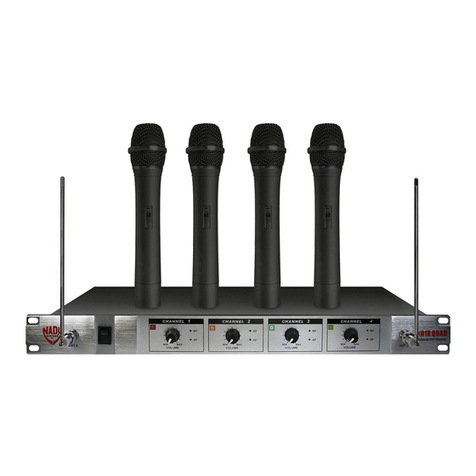
Nady Systems
Nady Systems 401X Quad user guide

Chiayo
Chiayo DWR-5420 Operation manual
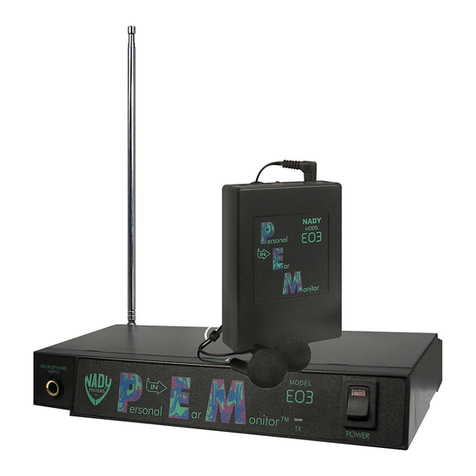
Nady Systems
Nady Systems Personal in Ear Monitor E03 owner's manual

Harrison
Harrison Hydra-Gen HU507-GB12 Installation and maintenance guide

Sense
Sense SE-300-WT-HAND manual
